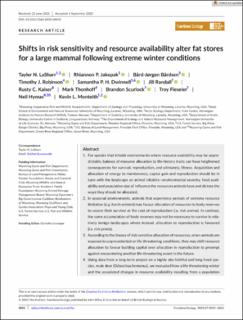| dc.description.abstract | For species that inhabit environments where resource availability may be unpredictable, balance of resource allocation to life-history traits can have heightened consequences for survival, reproduction, and ultimately, fitness. Acquisition and allocation of energy to maintenance, capital gain and reproduction should be in tune with the landscape an animal inhabits—environmental severity, food availability and population size all influence the resources animals have and dictate the ways they should be allocated. In seasonal environments, animals that experience periods of extreme resource limitation (e.g. harsh winters) may favour allocation of resources to body reserves to secure their survival at the cost of reproduction (i.e. risk averse). In contrast, the same accumulation of body reserves may not be necessary to survive in relatively benign landscapes where instead, allocation to reproduction is favoured (i.e. risk prone). According to the theory of risk-sensitive allocation of resources, when animals are exposed to unprecedented or life-threatening conditions, they may shift resource allocation to favour building capital over allocation in reproduction to preempt against encountering another life-threatening event in the future. Using data from a long-term project on a highly site-faithful and long-lived species, mule deer (Odocoileus hemionus), we evaluated how a life-threatening winter and the associated changes in resource availability resulting from a population reduction influenced how animals acquired and allocated energy to survival (i.e. fat accumulation). Per capita precipitation, and the associated reduction in population abundance after the severe winter, had a positive influence of accrual of fat over summer. After the extreme physiological stress of a hard winter, deer starting spring with low body reserves accumulated 2.8 percentage points more fat over summer compared with before the experience of a bad winter and had an increased probability of recruiting fewer offspring. Fat stores can interact with environment, life history and behaviour to influence survival during periods of resource scarcity. For a long-lived herbivore, we documented shifts in risk tolerance associated with fat accrual in preparation for winter, supporting the notion that risk-sensitive allocation of resources may be plastic—an essential adaptation for animals to cope with rapidly changing landscapes. | |
